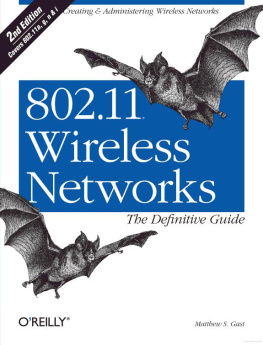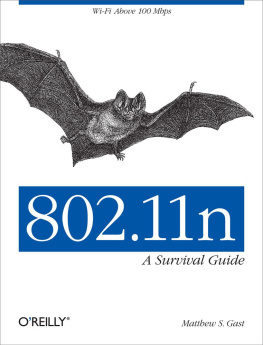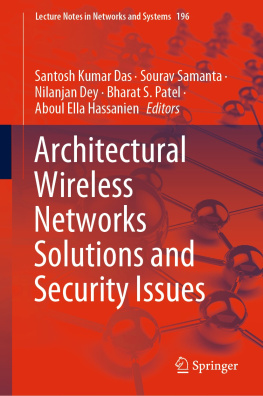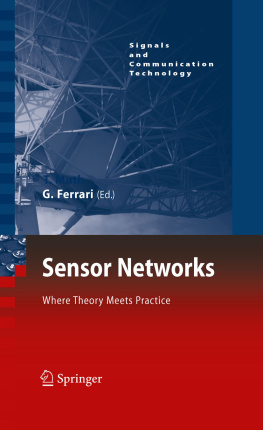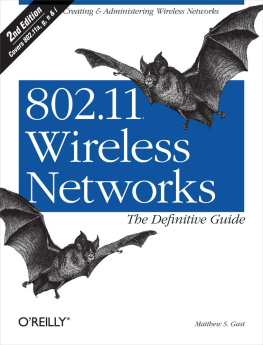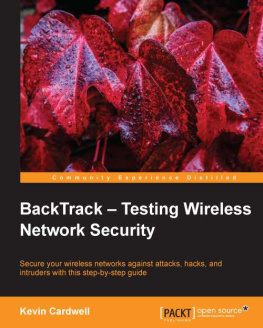Index
[]access points ( continued )aggregationAppleapplications
Index
[]bandsBeacon framesBeacon intervalBSSID (Basic Service Set ID)buffered framesbursting
Index
[]cachingchannelsclear channel assessmentMACciphersclear channel assessmentcollisionsconnectivitycontention-free periodcounterscryptographycipherscryptography ( continued )CSMA (Carrier Sense Multiple Access)CSMA/CA (Carrier Sense Multiple Access with Collision Avoidance)
Index
[]data processingdata transmissiondecryptionDHCP (Dynamic Host Configuration Protocol)direct sequence networksDS PHYDTIM (Delivery Traffic Indication Map)DTIM period
Index
[]packetsEAPOLencapsulationencodingdecryptionframesextended rate PHY (ERP)
Index
[]FCC (Federal Communications Commission)FH PHYfieldsfiltersFrame Control fieldframesbufferingencryptionframes, management frames ( continued )transmissionframingfrequency hopping
Index
[]
Index
[]hardwareinterface cardsheadersHEC (Header Error Check)higher-layer protocols
Index
[]inputintegrityinterface cardsinterfacesinterferenceinterframe spacing ( continued )ISM (Industrial, Scientific, and Medical)interferencethroughputIV (initialization vector)
Index
[]
Index
[]key hierarchykeysdynamicWEP
Index
[]LinuxPCMCIA
Index
[]accessMacintoshmanagement architecturemanagement frames, information elements ( continued )MIC (Message Integrity Check)
Index
[]NAKs (Null acknowledgments)network analysisnetworks
Index
[]parametersOFDM PMD
Index
[]packets, EAPparametersPCMCIA (Personal Computer Memory Card International Association)performanceperformance tuningpower managementrequirementssecurity
Index
[]
Index
[]radio linkradio modesradiosrateRC4 cipherreceptionreportingrequirements for project planningresponsesinterferenceRF (Radio Frequency)componentsRSN (Robust Security Network)RTS (Request to Send)
Index
[]scan reportssecurity ( continued )protocolsSFD (Start of Frame Delimiter)signalsheadersspectrum managementstream cipherssynchronizationtiming
Index
[]802.11g802.11b and802.1X
Index
[]TA (Transmitter Address)MACWWiSETGnSync PHYthroughputproject planningtimingsynchronizationtransitionstransmissionframes
Index
[]unicastUniversity of New Hampshire's Inter-Operability Lab
Index
[]
Index
[]keysWindowswireless extensions, Linuxwireless networksWWiSE (World-Wide Spectrum Efficiency) ( continued )MACTGnSync
Index
[]
Index
[]
Index
[]
Index
[]access points ( continued )aggregationAppleapplications
Index
[]bandsBeacon framesBeacon intervalBSSID (Basic Service Set ID)buffered framesbursting
Index
[]cachingchannelsclear channel assessmentMACciphersclear channel assessmentcollisionsconnectivitycontention-free periodcounterscryptographycipherscryptography ( continued )CSMA (Carrier Sense Multiple Access)CSMA/CA (Carrier Sense Multiple Access with Collision Avoidance)
Index
[]data processingdata transmissiondecryptionDHCP (Dynamic Host Configuration Protocol)direct sequence networksDS PHYDTIM (Delivery Traffic Indication Map)DTIM period
Index
[]packetsEAPOLencapsulationencodingdecryptionframesextended rate PHY (ERP)
Index
[]FCC (Federal Communications Commission)FH PHYfieldsfiltersFrame Control fieldframesbufferingencryptionframes, management frames ( continued )transmissionframingfrequency hopping
Index
[]
Index
[]hardwareinterface cardsheadersHEC (Header Error Check)higher-layer protocols
Index
[]inputintegrityinterface cardsinterfacesinterferenceinterframe spacing ( continued )ISM (Industrial, Scientific, and Medical)interferencethroughputIV (initialization vector)
Index
[]
Index
[]
Index
[]key hierarchykeysdynamicWEP
Index
[]LinuxPCMCIA
Index
[]accessMacintoshmanagement architecturemanagement frames, information elements ( continued )MIC (Message Integrity Check)
 | | 802.11 Wireless Networks The Definitive Guide | | By Matthew Gast | | ............................................... | | Publisher: O'Reilly | | Pub Date: April 2005 | | ISBN: 0-596-10052-3 | | Pages: |
|
|
 |
As we all know by now, wireless networks offer manyadvantages over fixed (or wired) networks. Foremost on thatlist is mobility, since going wireless frees you from thetether of an Ethernet cable at a desk. But that's just thetip of the cable-free iceberg. Wireless networks are alsomore flexible, faster and easier for you to use, and moreaffordable to deploy and maintain.
The de facto standard for wireless networking is the 802.11protocol, which includes Wi-Fi (the wireless standard knownas 802.11b) and its faster cousin, 802.11g. Witheasy-to-install 802.11 network hardware available everywhereyou turn, the choice seems simple, and many people dive intowireless computing with less thought and planning thanthey'd give to a wired network. But it's wise to be familiarwith both the capabilities and risks associated with the802.11 protocols. And 802.11 Wireless Networks:The Definitive Guide , 2nd Edition is the perfectplace to start.
This updated edition covers everything you'll ever need toknow about wireless technology. Designed with the systemadministrator or serious home user in mind, it's ano-nonsense guide for setting up 802.11 on Windows andLinux. Among the wide range of topics covered arediscussions on:
deployment considerations
network monitoring and performancetuning
wireless security issues
how to use and select accesspoints
network monitoring essentials
wireless card configuration
security issues unique to wirelessnetworks
With wireless technology, the advantages to its users areindeed plentiful. Companies no longer have to deal with thehassle and expense of wiring buildings, and households withseveral computers can avoid fights over who's online. Andnow, with 802.11 Wireless Networks: The DefinitiveGuide , 2nd Edition, you can integrate wirelesstechnology into your current infrastructure with the utmostconfidence.
|
Index
[]NAKs (Null acknowledgments)network analysisnetworks
Index
[]parametersOFDM PMD
Index
[]packets, EAPparametersPCMCIA (Personal Computer Memory Card International Association)performanceperformance tuningpower managementrequirementssecurity
Index
[]
Index
[]radio linkradio modesradiosrateRC4 cipherreceptionreportingrequirements for project planningresponsesinterferenceRF (Radio Frequency)componentsRSN (Robust Security Network)RTS (Request to Send)
Index
[]scan reportssecurity ( continued )protocolsSFD (Start of Frame Delimiter)signalsheadersspectrum managementstream cipherssynchronizationtiming

